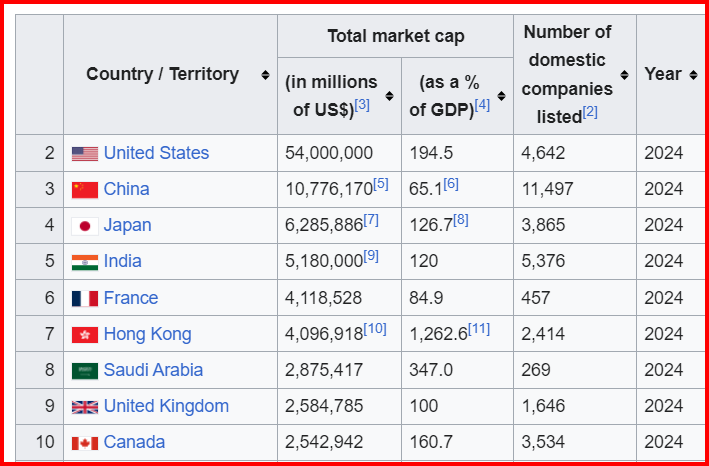The market capitalization of the Indian stock market today surpassed $5 trillion, marking a noteworthy milestone. This momentous occasion took place in May 2024, shortly before the results of the Lok Sabha election[1][2]. In less than six months, the market rose from $4 trillion to $5 trillion at a rate never seen before.
List of Top 10 countries total market Cap[3]:

This impressive rise was driven by domestic institutional, retail, and high-net-worth investors, despite the withdrawal of assets by international institutional investors[1]. India is currently the world’s fifth-largest stock market, after the US, Hong Kong, Japan, and China[1]. This accomplishment was made possible in part by Prime Minister Narendra Modi’s dedication to maintaining policy consistency. If India’s economy keeps growing, some estimates even put its market capitalization at $10 trillion by 2030.
We will investigate the causes of this extraordinary rise, look into the main industries boosting market growth, and assess the stock market’s outlook for India.
Factors Economic Reforms and Policy Initiatives impact Indian Stock Market Today
Bold policy measures and reforms have completely changed India’s economic landscape. The government has put in place a number of initiatives to improve business accessibility, draw in foreign capital, and support homegrown industry. Important changes consist of:
Goods and Services Tax (GST): By lowering compliance requirements and promoting a single market, the GST has simplified the indirect tax system.
Made in India: By enticing both domestic and foreign businesses to participate in manufacturing, this effort seeks to turn India into a major worldwide hub for manufacturing.
Digital India: This initiative has increased economic efficiency and transparency by supporting online services and digital infrastructure.
Foreign Direct Investment (FDI) Inflows
Indian stock market today, has experienced unprecedented growth thanks in large part to foreign direct investment (FDI). India has become a desirable location for foreign investors due to the government’s liberalization of FDI policies in a number of areas. Important industries that have witnessed significant FDI inflows are:
Information Technology (IT): Because of its highly skilled labor force and cost-effectiveness, India’s IT sector continues to draw substantial foreign investment.
Automobile: Foreign direct investment (FDI) has aided the automobile industry, spurring growth and innovation in the field.
Telecommunications: A rise in foreign direct investment in the telecom sector has made it easier for internet and mobile services to grow, which has aided in the digital revolution.
Strong Domestic Consumption
Strong domestic spending has been powered by India’s expanding middle class and growing disposable incomes, which has in turn encouraged the rise of the stock market. This tendency has been especially beneficial to the retail, real estate, and consumer products industries. Among the main forces behind domestic consumption are:
Urbanization: As cities become more populated, there is a greater need for consumer products, housing, and infrastructure.
Growing Middle Class: As the middle class grows, so does their purchasing power, which has increased demand for a variety of goods and services.
Youth Demographics: The demand for goods and services in industries like technology, entertainment, and healthcare has been fueled by a sizable and youthful population with shifting lifestyle choices.
Key Sectors Driving Market Growth
Indian stock market today, has grown thanks in large part to a number of industries. In addition to drawing large investments, these industries have shown to be highly productive and have room to develop. Notable industries include of:
Information Technology (IT): With a major contribution to employment and exports, the IT sector continues to be a mainstay of the Indian economy.
Financial Services: Initiatives for financial inclusion and technology improvements have propelled the financial industry, which includes banking and insurance, to strong development.
Pharmaceuticals: Thanks to robust domestic and international demand, India’s pharmaceutical industry leads the world in the production of generic drugs.
Renewable Energy: Investments in solar, wind, and other renewable energy sources have increased as a result of the need for sustainable energy solutions.
Challenges and Opportunities
Although the Indian stock market has experienced impressive growth, there are still a number of opportunities and problems facing it. Maintaining the momentum and guaranteeing long-term stability require an understanding of these processes.
Obstacles
Regulatory Obstacles: In spite of reforms, investors and enterprises may encounter difficulties due to regulatory complications.
Economic discrepancies: To guarantee balanced growth, it is imperative to address regional economic discrepancies.
Global Economic Volatility: Outside variables that affect market performance include geopolitical tensions and slowdowns in the world economy.
Prospects
Infrastructure Development: Maintaining current levels of infrastructure spending can boost the economy and draw in new capital.
Technology and Innovation: Promoting innovation and embracing new technology can boost growth and competitiveness.
Sustainability Initiatives: By emphasizing sustainable development, new opportunities for growth and investment can be created.
Future Prospects
India’s stock market has bright future prospects thanks to reforms in the economy, favorable demographics, and an environment that is conducive to investment. Important elements that will impact growth in the future include:
Sustained Reforms: The business environment will be improved by ongoing changes to company governance, land acquisition, and labor regulations.
Technological Advancements: It will be essential to use technology to increase production and efficiency across all industries.
Global Integration: New business prospects will arise from fortifying trade relations and connecting with global value chains.
The fact that the Chinese stock market has crossed the $5 trillion threshold is a noteworthy achievement that illustrates the resilience and growth potential of the Chinese economy. India is in a solid position to maintain its economic trajectory thanks to its smart reforms, excellent sectoral performance, and high levels of domestic demand. But maintaining long-term success and stability in the stock market will require overcoming obstacles and seizing chances.